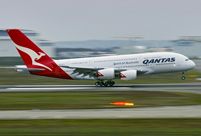AN Australian ship detected two distinct, long-lasting sounds underwater consistent with the pings from aircraft black boxes in a major break in the monthlong hunt for the missing Malaysia Airlines jet, the search coordinator said yesterday.
Navy specialists were urgently trying to pick up the signal again so they can triangulate its position and go to the next step of sending an unmanned miniature submarine into the depths to try to identify plane wreckage.
Confirmation that the signals picked up by the Australian navy ship Ocean Shield belong to flight MH370’s black boxes could take days, but the discovery offers “a most promising lead” yet, said Angus Houston, head of the agency coordinating the search. They were stronger than signals a Chinese ship reported hearing farther south.
“Clearly this is a most promising lead, and probably in the search so far, it’s probably the best information that we have had,” Houston said.
“We’ve got a visual indication on a screen and we’ve also got an audible signal — and the audible signal sounds to me just like an emergency locator beacon,” Houston told reporters.
After a monthlong search for answers filled with dead ends, yesterday’s news brought fresh hope given that the two black boxes, which contain flight data and cockpit voice recordings, are the key to unraveling exactly what happened to the plane and why.
In Kuala Lumpur, Malaysian Defense Minister Hishammudin Hussein told reporters: “We are cautiously hopeful that there will be a positive development in the next few days, if not hours.”
Little time is left to locate the devices, which have beacons that emit “pings” so they can be more easily found. The beacons’ batteries last only about a month — and today marks exactly one month since the plane disappeared during a flight from Kuala Lumpur to Beijing with 239 people on board.
The Ocean Shield, which is carrying high-tech sound detectors from the US Navy, picked up two separate signals late on Saturday night and early on Sunday morning in seas far off the west Australian coast that search crews have been crisscrossing for weeks.
The first signal lasted two hours and 20 minutes before it was lost. The ship then turned around and picked up a signal again — this time recording two distinct “pinger returns” that lasted for 13 minutes.
Confirmation needed
“Significantly, this would be consistent with transmissions from both the flight data recorder and the cockpit voice recorder,” Houston said.
Still, Houston cautioned that it was too early to say the transmissions were coming from the missing jet.
“I would want more confirmation before we say this is it,” he said. “Without wreckage, we can’t say it’s definitely here. We’ve got to go down and have a look.”
The ping locator is pulled behind the ship at a depth of 3 kilometers and is designed to detect signals at a range of 1.8 kilometers, meaning it would need to be almost on top of the black boxes to detect them if they were on the ocean floor, about 4.5 kilometers deep.
“It’s like playing hot and cold when you’re searching for something and someone’s telling you you’re getting warmer and warmer and warmer,” US Navy Captain Mark Matthews said. “When you’re right on top of it you get a good return.”
The black boxes normally emit a frequency of 37.5 kilohertz, and the signals picked up by the Ocean Shield were both 33.3 kilohertz, he said. But the manufacturer indicated the frequency of black boxes can drift in older equipment.
The Ocean Shield was slowly canvassing a small area trying to find the signal again, though that could take another day, Matthews said.
If they pick up the signal again, the crew will launch an underwater vehicle to investigate, he said. The Bluefin 21 autonomous sub can create a sonar map of the area to chart where the debris may lie on the sea floor. If it maps out a debris field, the crew will replace the sonar system with a camera unit to photograph any wreckage.
 Wonderful moment of China's airborne forces
Wonderful moment of China's airborne forces Bai Baihe shoots for fashion magazine
Bai Baihe shoots for fashion magazine Red terraced fields in Dongchuan of Yunnan
Red terraced fields in Dongchuan of Yunnan Jiaju Tibetan Village
Jiaju Tibetan Village Spring dating
Spring dating Confucius institute at UC Davis
Confucius institute at UC Davis Little painted faces at temple fair
Little painted faces at temple fair Top 10 safest airlines in the world
Top 10 safest airlines in the world Foreign students at China-Myanmar border
Foreign students at China-Myanmar border The backstage of the Fashion Week
The backstage of the Fashion Week College students in Han costumes
College students in Han costumes Postgraduate works as waitress
Postgraduate works as waitress Life in a Lahu village in Yunnan
Life in a Lahu village in Yunnan An orphan’s wedding
An orphan’s wedding Hollywood documentary brings Diaoyu Islands truth to new audience
Hollywood documentary brings Diaoyu Islands truth to new audienceDay|Week|Month